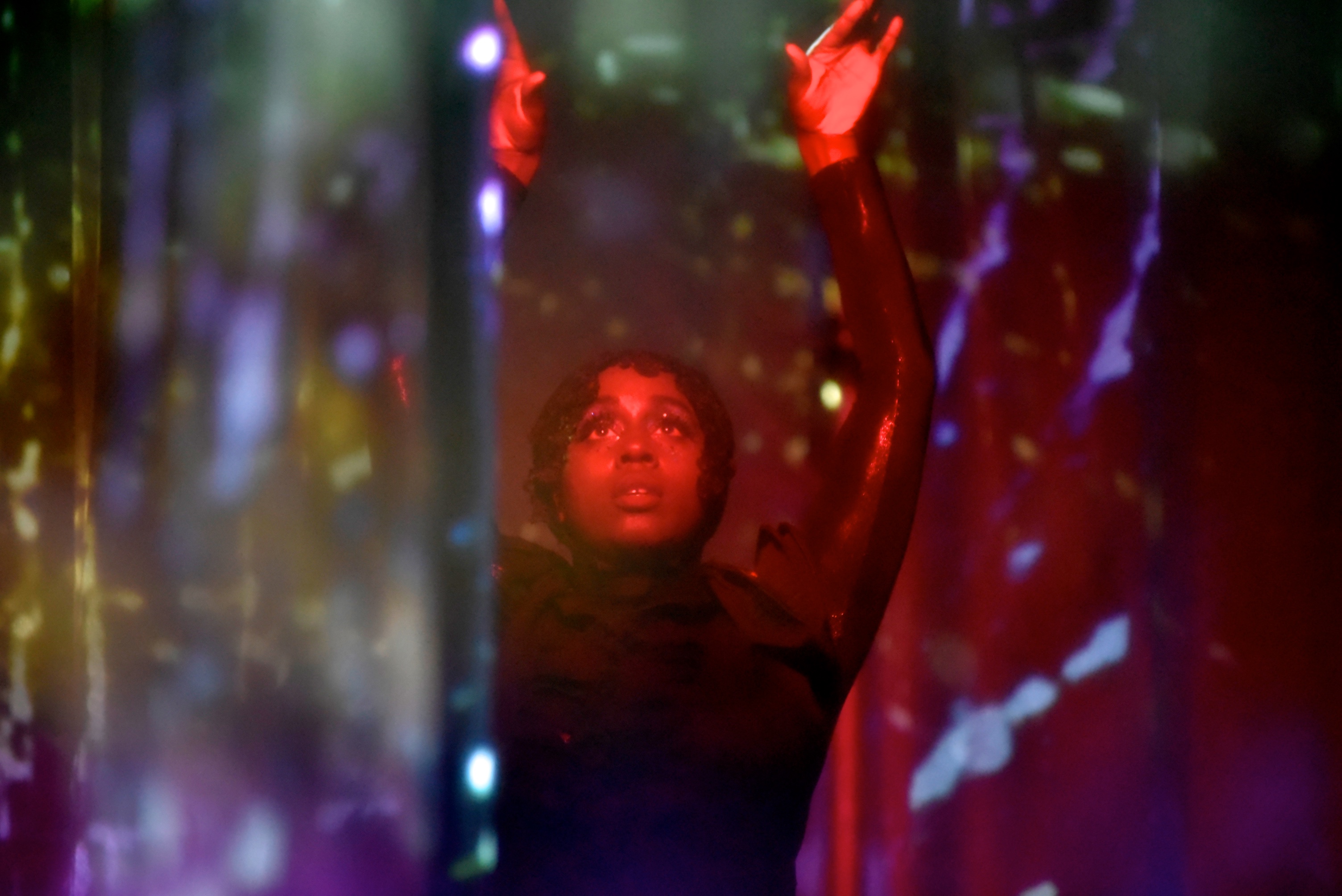
distorted constelations, exhibitions, interview, Nwando Ebizie, visual artist
Nwando works across media, genre and artforms creating mythopoetic metanarratives and alternate realities. Her work is a drawing together of the pieces that she is in a frozen moment of ever-living infinite regress. She challenges her audience to question their perceived realities through art personas, experimental theatre, neuroscience, music and African diasporic ritualistic dance.
In Conversation with visual artist Nwando Ebizie
Fizzing silhouettes, low synths, dancing in the dark: ‘Distorted Constellations’ captured imaginations at Manchester’s PUSH festival and Brighton Festival earlier this year. The immersive installation of music, holograms, ritual and dance was designed by Nwando Ebizie, who also performs as part of the work.
At the heart of the piece is Ebizie’s experience of a rare neurological condition that was barely recognised until 2014.
‘Visual snow’ came into the mainstream five years ago when Brain, a neurology journal, a paper was published about the experiences of 22 patients. Commonly, people with the condition have their sight disturbed by dots in their field of vision – often compared to TV static. Many also suffer migraines. Authors noted that some patients with visual snow had first been had symptoms misdiagnosed as side effects of anxiety, depression, or even after-effects of LSD. The condition can develop mid-life, or be with patients from birth. There is no cure, and it affects vision, hearing and cognition. For some, it can be disabling.
For audiences who already experience visual snow, seeing ‘Distorted Constellations’ may be the first time anyone has portrayed, projected and shared the embodied experience of visual snow with people who have no experience of it.
Ebizie always solicits responses from the audience. (Amongst the 289 recorded in Brighton: ‘one of the most amazing sensory experiences I’ve had’, ‘timeless’, ‘amazing’). Extraordinary encounters seem to be the norm. Recently, she recalls: “An artist who came said that she recently got visual snow. She had had to quit her job: she worked in theatre as a set designer, and she just felt like she couldn’t do her job anymore.
“Coming to see my project changed her mind because she saw me creating this visual art piece, as someone who has visual snow, and said: ‘Oh, you know, if she can do it then maybe I can still do it.’”
For people affected by visual snow, the work offers them a unique chance to connect and access new research, Ebizie explains: “One of the important things about the project is that it’s offering a model whereby you can have art and science sitting together. You can create an experience that can somehow feeds back into scientific research.” In Manchester, for example, Ebizie hosted an event with Dr Francesca Puledda, a neurologist researching the pathophysiology of the condition at King’s College London. People travelled from Cornwall and Doncaster to attend.
As well as crossing the ‘two cultures’ divide between arts and science, for Ebizie ‘Distorted Constellations’ also fulfills a social mission: “When I started researching visual snow, one of the things I realised is how despairing some people are who have visual snow, and how depressed and anxious it makes them to suddenly have their perception completely change.”
She was doing a project for the Wellcome Collection when she began to develop ideas around visual snow: “Because it was only discovered in 2014, there’s this thing of feeling like it just suddenly appeared. There’s no evidence it has just appeared, but there’s no evidence that it hasn’t just appeared either.”
When she began looking through their library for accounts of symptoms dating from before 2014, she drew a blank: “I couldn’t really find anything, but I realised it was because language and perception is so slippery. One of the main descriptors of visual snow symptoms is seeing something that looks like TV static, which is obviously only something something someone could describe from the latter end of the 20th century.
“What would somebody have described to us before? So I started looking at other artists, like Van Gogh, like Seurat, who maybe created their reality in a way that actually describes what they’re actually seeing or experiencing.”

For many, tackling such a huge new subject might be intimidating, but for Ebizie she thrives on the opportunity to deep-dive into fresh subjects with every project: “The way I work is, each of my projects works in quite different art forms and quite different kind of subject matters because I get really interested in something and go really in-depth into it. The process always begins with learning a new idea, subject matter or technique. With Distorted Constellations I became a Fellow In Immersion with an organisation called the South West Creative Technology Network and learned about immersive technology. With the opera I’m currently creating I researched medieval Benedictine ritual.”
When I ask her whether she faces any difficult moments working on ‘Distorted Constellations’, she replies: “It’s always really difficult. I’m trying to create something that’s a model of my perceptual reality, which we already know is something that most people don’t have and they can’t empathise with. Neuroscientists now understand that brains are inherently unique, and exist on a spectrum, with some being more typical and some being more atypical.
“Trying to create the installations, trying to create the systems of the project, can be really frustrating for everyone involved. It’s a collaborative project, so you’re constantly trying to find a shared language of something that hasn’t been created. It’s inherently creative and interesting, but it is also really tiring to feel that you’re constantly explaining yourself, and explaining why certain things are important.”
The stress was particularly sharp because the work combines two intensely personal (and poorly understood) subjects: “There is a lot of personal material in the idea of the project, because it’s this exhibition that, in a wide sense, is trying to encapsulate my reality. A part of that is my interest in Afro-diasporic ritual, and that’s very much within it, which is a whole other area which most people don’t know about. Having to explain that and weave that in isn’t… Yeah, it’s … Interesting.”
In ‘Distorted Constellations’, immersive sounds and imagery become a medium for sharing the spiritual knowledge and experience that underlie the project.
One of the two key technologies in ‘Distorted Constellations’ is its visuals. Ebizie’s work with a neuroscientist, Ed Bracey, into neural pathways inspired Its labyrinthine design. Another artist-technologist, Coral Manton, co-developed projections that mimicked visual snow.
The installation’s other key technology is its ambisonic system. Unlike a typical two-speaker stereo system used in many installations as well as cinemas and venues, ‘Distorted Constellations’ has a 360-degree sound setup (in Manchester, on eight speakers, and at other venues, six) to create a more surrounding, immersing sonic environment for its sound ‘palette’ of others’ visual snow symptoms.
Key to the success of the installation was finding ways to make it more accessible. One collaborator, Guillaume Dujat, produced a binaural mix of Ebizie’s original composition, ‘Twenty Minutes of Action’, by recording the sounds from the ambisonic system on a dummy ‘head’ (the mics sit where the ears would be. For people who will listen to the composition on headphones or audio loop, it provides a really close simulation to listening in-situ). For those who can’t attend the installation in person, an online 3D ‘game’ version of the exhibition is in development.
It’s been a huge year for the artist. As well as touring ‘Distorted Constellations’, Ebizie also held a fellowship with the Southwest Creative Technology Network, launched a new composition at King’s Place last October, and was one of six artists to win the UK’s biggest award for women in experimental music last summer. The Daphne Oram prize, awarded last June, was presented for her work in her pop persona, Lady Vendredi, which has taken her to packed audiences at the Barbican, the Roundhouse and a BBC Music stage at Latitude.
But her achievements have also brought their own stresses with them. From autumn last year to the following May, when Ebizie started working intensively on ‘Distorted Constellations’, she experienced a ‘pretty consistent’ panic disorder: “I was having a lot of anxiety issues and depressive symptoms. I found most things that I do quite difficult because of that.”
A change of scene has helped, she says: “It’s given me more headspace. I felt a constant crushing weight of too much going on, always being on the go. People aren’t like that outside of London.”
She left London a couple of years ago to move to the Calder Valley, and has been wild swimming and fell-running in her spare time. “If you had told me two years ago I would be doing that I would have laughed in your face,” she jokes, “‘I would never get in zero degrees water, that’s insane’.
“I’m surrounded by the hills so it’s really easy to get away – I mean, not always, because sometimes walking out the door is difficult. But it’s easier than being in London, in that you can go away. In two minutes I’m surrounded by hills, and no people, and sheep.”
Another year looms, and another project. Up next: an opera about a 12th-century mystic. Ebizie discovered Hildegard von Bingen during research into possible historic cases of visual snow. The mystic had already been retrospectively diagnosed by Oliver Sacks, she notes, with what might have been scintillating scotoma. Ebizie performed some original compositions from the opera at King’s Place in London last August, but has even grander plans for the project: “I want to build it up so it’s this kind of modern, secular ecstatic experience related to the ritual that Hildegard, or someone like her, would have gone through when they entered a monastery as a child … A death ritual with a funeral liturgy spoken over them as they laid on the ground, covered in leaves. They would have had to say, ‘I’m leaving this world now…’” She would have been about eight.”
To Ebizie, Hildegard’s significance was more about than her neurodivergence: “I was just really interested in the mind of someone who had that and but was also this crazy, incredible genius at this time when that was so difficult to be. She was crazily strong-willed enough to do it.” As two stars draw together, a new constellation appears.
Interviewed by: Ellie Broughton
Ellie Broughton (elliebroughton@gmail.com) is an arts writer and copywriter with experience writing for The Guardian and Guardian Labs, The Huffington Post, The Independent and Vice. She is also the essays reader for Litro.



